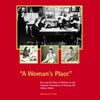Summary
“‘A Woman’s Place’: Art and the Role of
Women in the Cultural Formation of Victoria, BC, 1850s-1920s”
is one of seventeen CURA (Community-University Research Alliance)
research projects conducted by the University of Victoria’s
History in Art Department. Working in collaboration with the BC
Heritage Branch and the Royal BC Museum, the project culminated in the fall of 2004 in an exhibition
at the Maltwood Art Museum and Gallery
September 1, 2004 – January 11, 2005. Led by Dr. Karen Finlay,
History in Art Department, and Jennifer Iredale, Curator, BC Heritage
Branch, the project brought together a team of twenty-seven
student researchers and a large network of community participants:
museum specialists, archivists, private collectors, and local art
guild members. The exhibition featured over two hundred artifacts from
approximately a dozen local lenders, among them the BC Archives,
Royal BC Museum, Sisters of St. Ann Archives, Mount St. Angela,
Christ Church Cathedral, Point Ellice House, Art Gallery of Greater
Victoria, Craigflower Schoolhouse and Manor, and Craigdarroch Castle
Historical Museum Society.
Extensive primary research was conducted for the exhibition,
which explored the nature of art production by women in Victoria
in both the public and private spheres. The project rejected a narrow
definition of art that acknowledges only “fine art”
and “avant-garde art,” categories which have tended
to serve male artists. Instead the exhibition favoured an expansive
definition that includes the so-called decorative and applied arts.
This strategy was intended to help reclaim women’s identities,
so often hidden, as creative, technically skilled, and influential
in the social, economic, and cultural make-up of Victoria. Among
the mediums represented were painting, drawing, photography, basketry,
weaving, lace-making, embroidery, china painting, pottery, architecture,
and interior design. Among the artists featured were: Sarah Crease,
Hannah Maynard, Sister Osithe, Edith Carr, Mary Riter Hamilton,
Doris Holmes, Fanny Pirrie, Kathleen O’Reilly, Dolly Helmcken
Higgins, Martha Douglas Harris, and Sophie Pemberton. The exhibit
also included a selection of local First Nations women’s art.
The exhibition considered the disproportionately large role played
by women in art practice in Victoria between the 1850s and 1920s.
Women were instrumental in art education and the institutionalization
of art learning and art making in Victoria. While their art was
often relegated to “the accomplishments” and “good
deeds,” and women of all classes and ethnic groups faced resistance
to making art outside the home, the economic import of their artistic
production was considerable. At least two of the settler women who
arrived in Victoria in the wake of the Gold Rush in the late 1850s
and early 1860s – Antoinette Borde and Hannah Maynard –
were among those who supported themselves with their art: lace-making
and photography, respectively. Women, non-native and native, serving
diverse agendas, played a critical role in the wide dissemination
of First Nations art and design, as well as in the development of
local cottage craft industries and tourism. The title of the exhibition
was intended to be ironic; “a woman’s place,”
it is ventured, was not only “in the home.” Despite being
delimited in so many respects by a domestic setting, the trajectories
of women’s activity, networking, and influence extended into
diverse, often unexpected, areas.
The exhibition was funded by the CURA grant from the Social Sciences and Humanities Research
Council of Canada and received generous financial support from
Angie and Ralph Roberts. It also prompted a well-attended public symposium on Sunday November 28 at the University
Centre Senate Chambers. The symposium featured talks by Kathryn
Bridge, author of "By Snowshoe, Buckboard & Steamer: Women
of the Frontier" and "Henry & Self : the Private Life
of Sarah Crease 1826-1922"; Irene Bjerky, from the Faser Heritage
society; Kerry Mason, Emily Carr specialist; and John
Adams, historian and author of "Old Square Toes and his Lady";
as well as presentations by students involved in the "A Woman's
Place" CURA Project. The symposium
was followed by guided tours of the exhibition.
An extensive catalogue, written by the UVic researchers, accompanied the exhibition. The ground-breaking work in the catalogue is intended as the basis for continued research on early women artists in British Columbia. For copies of 'A Woman's Place': Art and the Role of Women in the Cultural Formation of Victoria, BC, 1850-1920s, please contact the Maltwood Art Museum and Gallery.
|
|
Image Gallery
|

|
|

